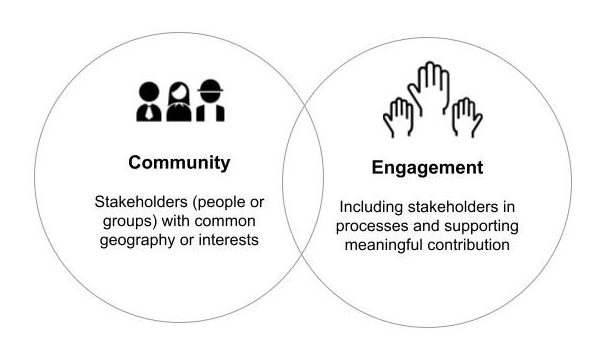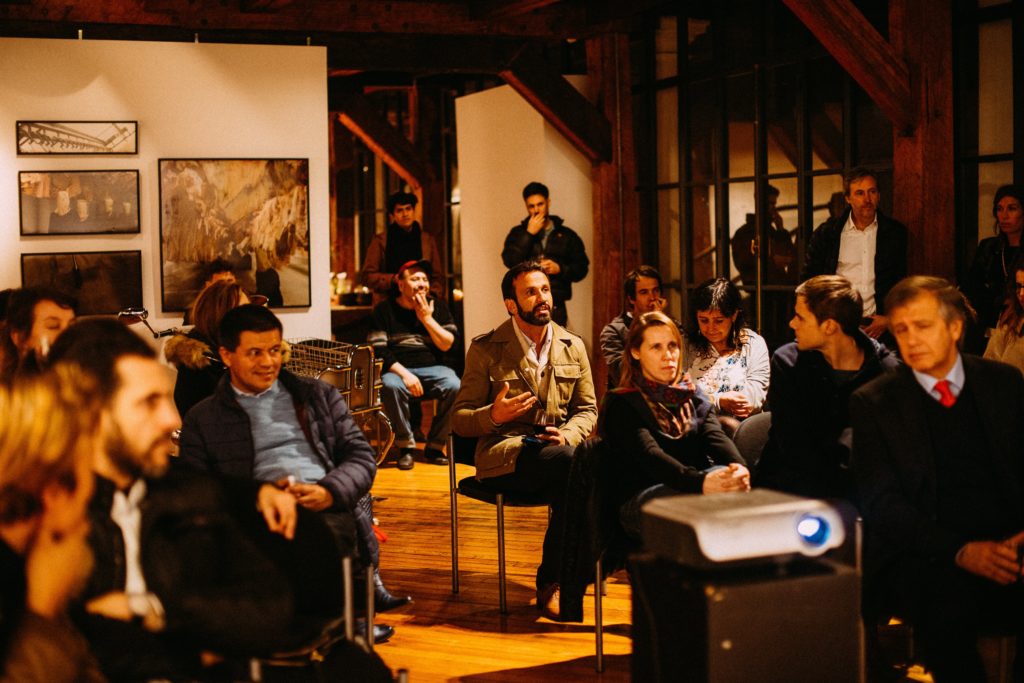Community Engagement: Definitions, Benefits & Examples

Community engagement is a powerful force for governments, corporations, nonprofits, and education institutions (as well as communities themselves).
It’s a phrase you’ll likely hear again and again if you’re a project manager, business leader, council/government employee, health executive, university researcher, or growth-minded businessperson.
But what actually is community engagement? And is it really worth all the effort that some organizations put into it?
Let’s explore the basics of community engagement, including definitions, benefits, how it works, and some examples.
What is Community Engagement?

Community engagement involves taking a strategic approach to an organization’s community-based stakeholders. This includes building relationships, developing communications, and managing interactions in order to achieve specific outcomes for the organization and the community itself.
To expand further, community engagement is a type of stakeholder engagement. Other terms used to talk about community engagement include civic engagement, public consultation, public participation, community consultation, community collaboration, stakeholder management, and community management.
To better understand the meaning of community engagement, we can break down each word:
- Community – Groups of people based on common geography (country, state, region, suburb, neighbourhood, etc.) or common interest (customs, values, religion, needs, etc.), which may include citizens, businesses, residents, stakeholders, and more
- Engagement – The act of including stakeholders in activities and communications and allowing them to contribute in a meaningful way
The United Nations Community Engagement Guidelines on Peacebuilding and Sustaining Peace also includes a usual definition for what community engagement is:
| “Community engagement” is a strategic process to directly involve local populations in all aspects of decision-making, policy development and implementation to strengthen local ownership, capacities and community structures as well as to improve transparency, accountability and optimal resource allocations across diverse settings. |
Why Community Engagement Matters
Building relationships with the community, communicating with them, and giving them opportunities to participate seems like a lot of work… is it really worth the effort? The short answer is: yes, of course!
But let’s expand on the benefits of community engagement and why it matters for organizations.
- Make better decisions – Community engagement gives you more information and perspectives, which can help you make decisions that consider the bigger picture and impact on all your stakeholders
- Be socially responsible – By engaging with the community, you can become more aware of social, environmental, and economic factors at play and (hopefully) contribute in a positive way
- Increase trust – By communicating with community members, you demonstrate greater transparency, which can help to build trust
- Gain a license to operate – Increased trust and satisfaction as a result of community engagement can make it more likely that your organization and project will gain community acceptance (in other words, a social license to operate)
- Successfully manage conflict and negotiate – By strategically engaging with the community (identifying and analyzing stakeholders), you can pinpoint potential sources of conflict earlier, as well as identify potential common ground that might help different groups (and your organization) negotiate and move forward with the project
Overall, both organizations and communities have a lot to gain from a successful community engagement.
What’s Involved in Community Engagement?

We’ve defined community engagement and discussed some of its merits. But what does the community engagement process actually look like? To sum it up, community engagement is all about strategy, communication, and relationships. But let’s expand on these a little…
Getting Strategic About the Engagement
The best place to start with your strategy is to make a community engagement plan. This plan should outline who your stakeholders are in the community, the outcomes you want to achieve, and how you’ll achieve them. Plus, analyze those stakeholders to understand their interests, impact, influence, relationships, and other characteristics — as this will allow you to take a more targeted approach.
Speaking of strategy, it’s always smart to think longer term when it comes to community engagement. Consider not just the projects and issues you’re focused on right now, but also those you may need to engage community members on in future. Investing in community engagement can help you better manage and avoid risks, gain trust and credibility you can lean on, and build connections that lead to bigger and better things (for your organization and the community).
Communication That Encourages Involvement
Good communication is key to successful community engagement (we talk a lot about this as a stakeholder engagement best practice). Here’s what you need to know…
Some parts of your community engagement may simply involve providing information to stakeholders. But for the most part, your goal will be to facilitate two-way communication, encouraging community members to participate in discussions and provide feedback.
To encourage this, you need to make sure you have representatives that are available and easily contactable via the platforms community members are comfortable with. For example:
- Social media
- Local events and markets
- Major shopping centers
- Libraries
- Schools
- Phone
- Live chat
Each interaction presents an opportunity to build relationships, trust, and understanding — plus, gain valuable insights that can lead to better informed decisions. So, you also need to be prepared to listen, respond quickly, and follow up. Thank community members for taking the time to share their perspectives, feedback, and ideas — and respond to them in a meaningful way.
If everything is going well, many community members will likely be keen to get involved further. In fact, getting participation from the community is one sign of community engagement success. So, keep your stakeholders informed on any opportunities to be part of the project, influence policies, or help to make decisions.
To encourage more participation, make it clear that you want their involvement and promote the benefits of partnering with your organization!
Building Better Relationships
We’ve already touched on this, but relationship building is an integral part of what community engagement is all about. If you’re doing a good job of communicating and connecting with stakeholders, this will naturally happen.
Strong relationships with the community can encourage more people to consider your organization’s perspectives alongside their own. If you’ve built enough trust (especially over a long period), they may be more open to your proposed changes.
But one additional benefit of an engaged community is that they won’t just build relationships with your organization. Often, the project and engagement may build relationships within the community, too. And this can lead to stronger, more resilient communities.
By the way, you can make it easier to build long-term relationships with community members by tracking their details and interactions via stakeholder management software like Simply Stakeholders.
3 Community Engagement Examples
The best way to really understand what community engagement is (and what it can do for organizations and communities) is to look at real examples, like the following:
1. Community Engagement in Government
In many government organizations, community engagement is critical but also challenging due to difficulty getting started, getting engagement, and getting their engagement processes up-to-date. Fortunately, many of these organizations are overcoming the challenges by updating their knowledge and implementing newer software like Simply Stakeholders.
As we shared in our article on strategies for community engagement in government, The United States Department of Energy uses Simply Stakeholders to support their community engagement process. In order to evaluate grant applications and determine eligibility (and award amounts), the department relies on independent subject matter experts. By managing these experts inside stakeholder software, the department can organize them into groups based on expertise, location, and other characteristics to quickly identify the ideal expert for a specific grant. They are able to track their areas of expertise, past programs they’ve been involved in, various characteristics including DEI categories, making it easy to quickly identify suitable experts for new grant programs.
2. Community Engagement to Support Sustainable Development
One significant benefit of community engagement is tapping into a broader range of perspectives and insights. We’ve looked at several sustainability projects that encouraged public participation, from wind farms to a desalination plan and found that community participation can help to shape projects so that they’re more sustainable and better serve the community. Another key finding was that organizations can learn more (and get more buy-in) if they begin engaging the community from the beginning — it’s never too early to get started.
3. Agricultural Community Engagement Initiatives in Rural Libraries
One report looked at how agricultural-focused community engagement activities in rural libraries can have a positive impact. These initiates included a farmers’ market, community gardens, and a seed library. The report found that communities benefited from the initiatives, particularly through networking, skill building, community education, and seed preservation. And libraries benefited from increased foot traffic and utilization, with greater circulation of farm and food-related books.
Upgrade Your Community Engagement Tool

Ready to start simplifying your community engagement process? Powerful stakeholder software like Simply Stakeholders can help you track your contacts (and interactions), analyze your stakeholders, communicate with individuals, generate reports, and much more.
If you’d like to learn more, explore critical features for your community engagement tool or learn more about what to look for when investing in community engagement software. When you’re ready, reach out to our team to request a demo!






























